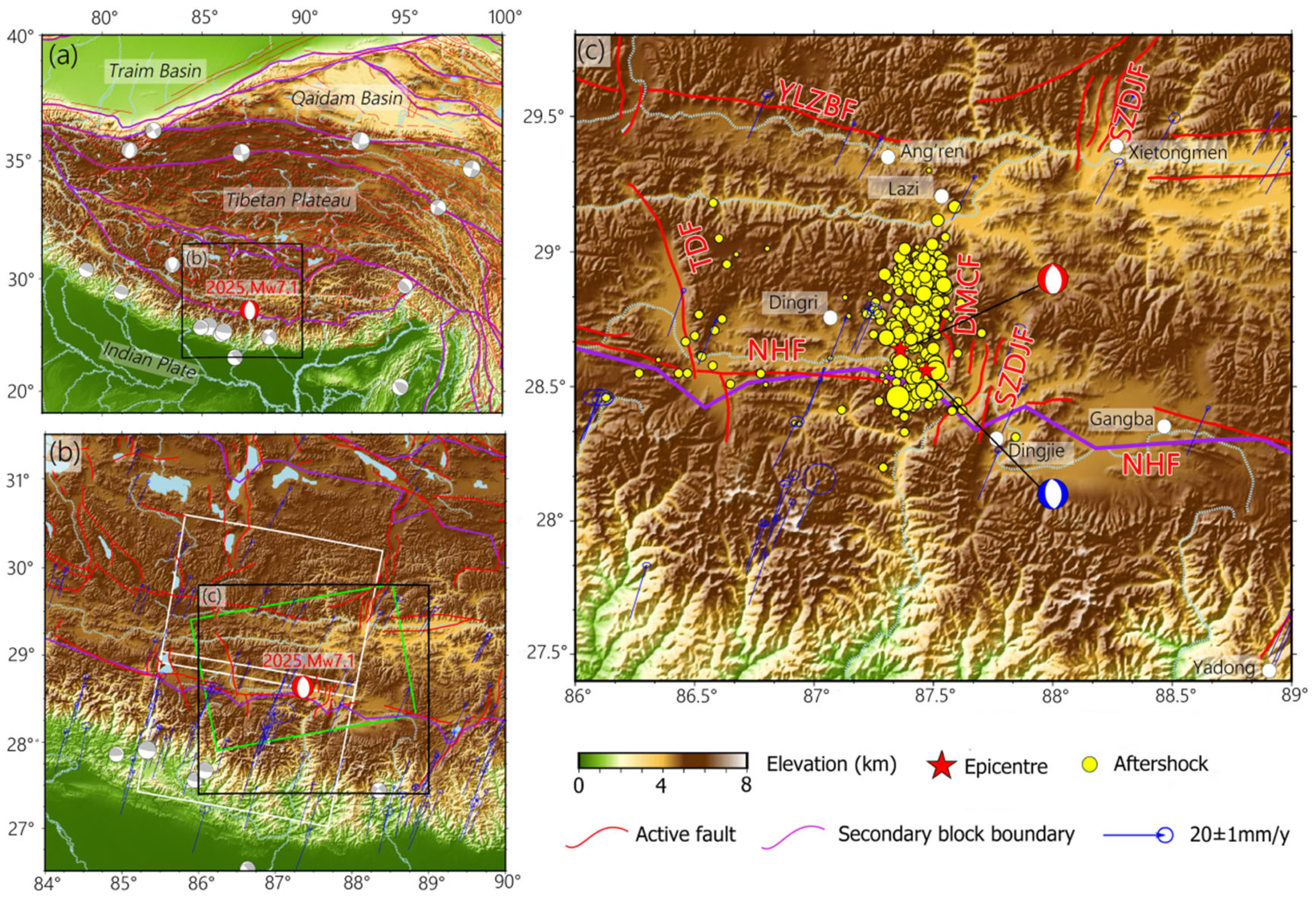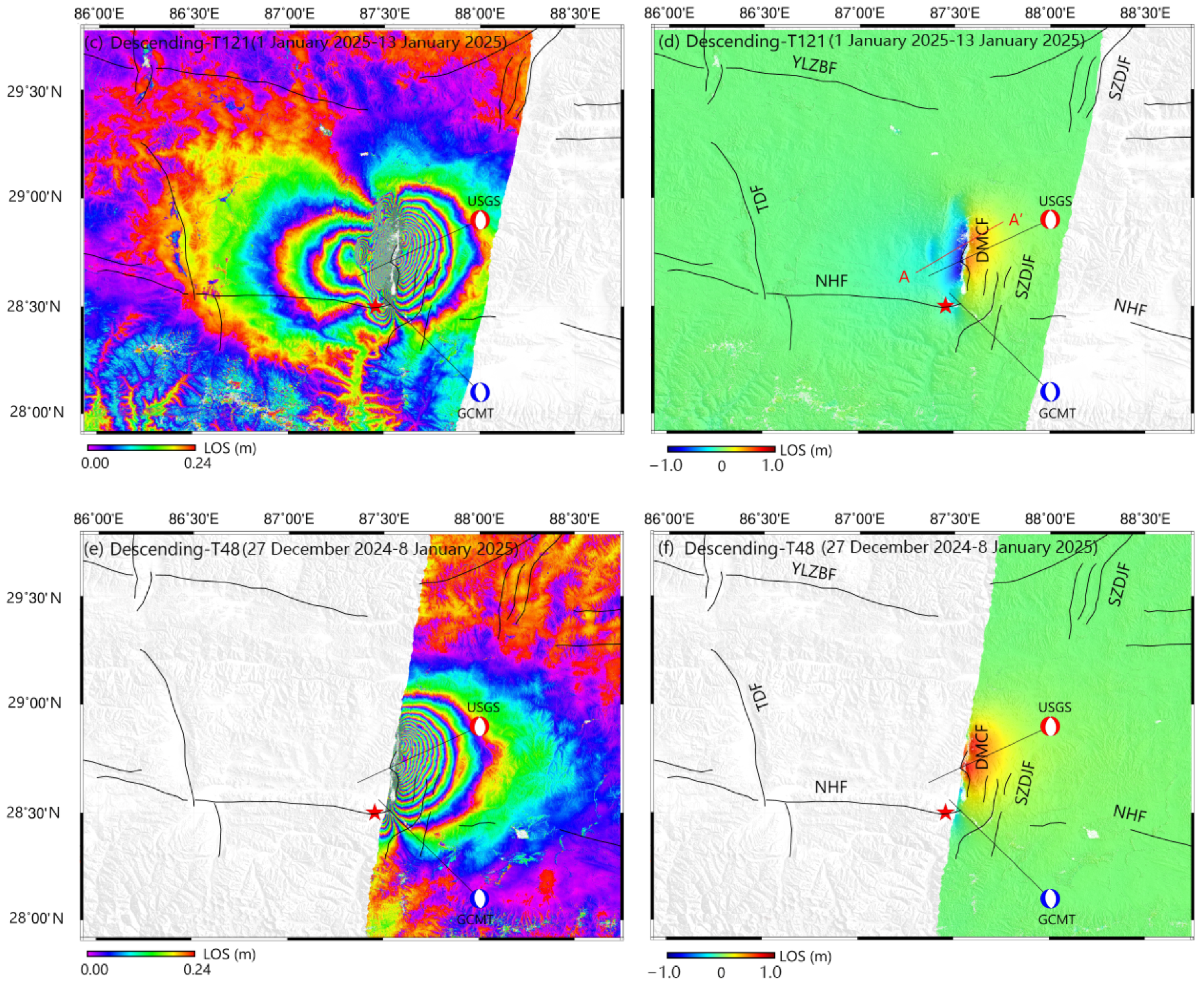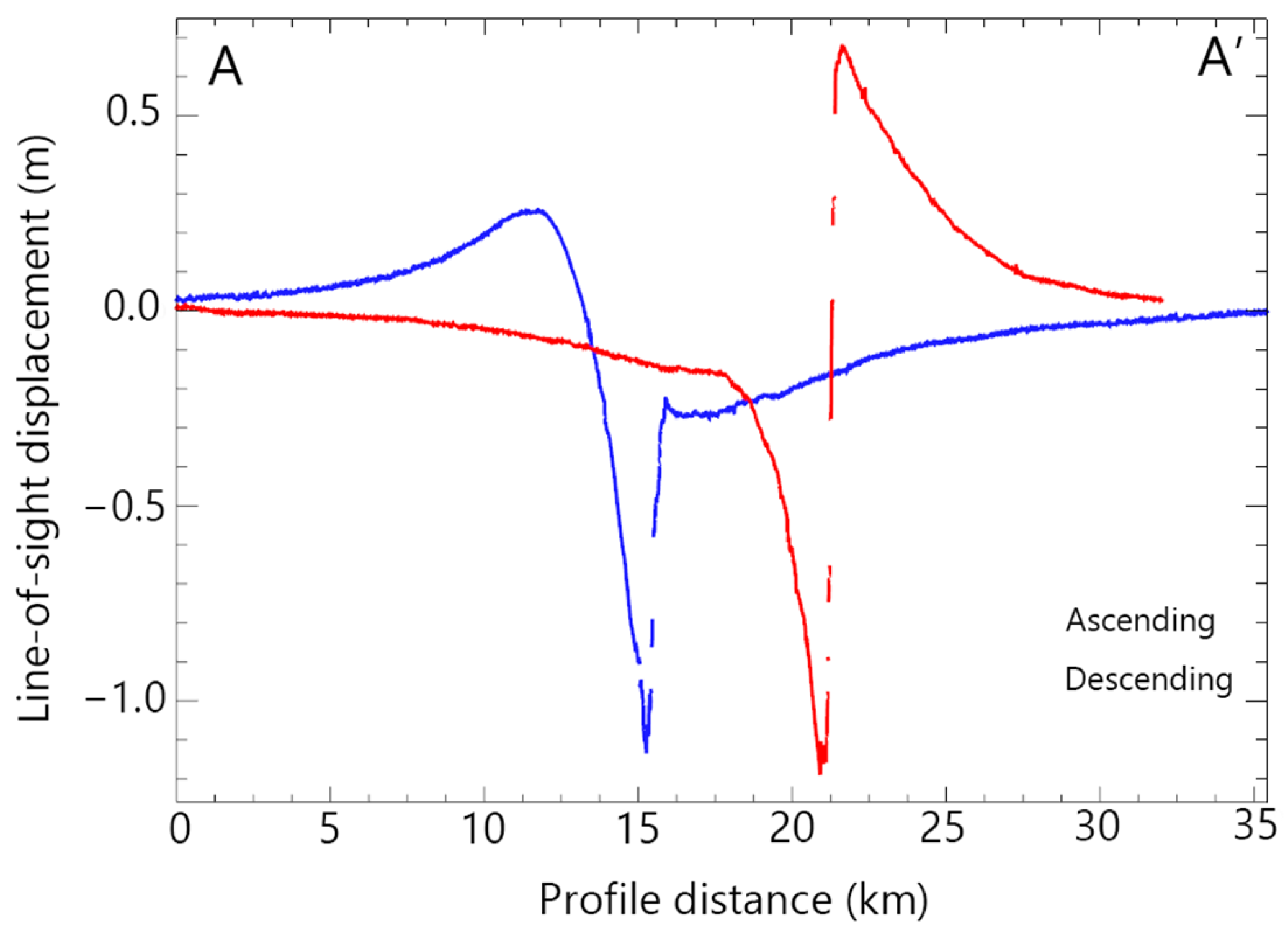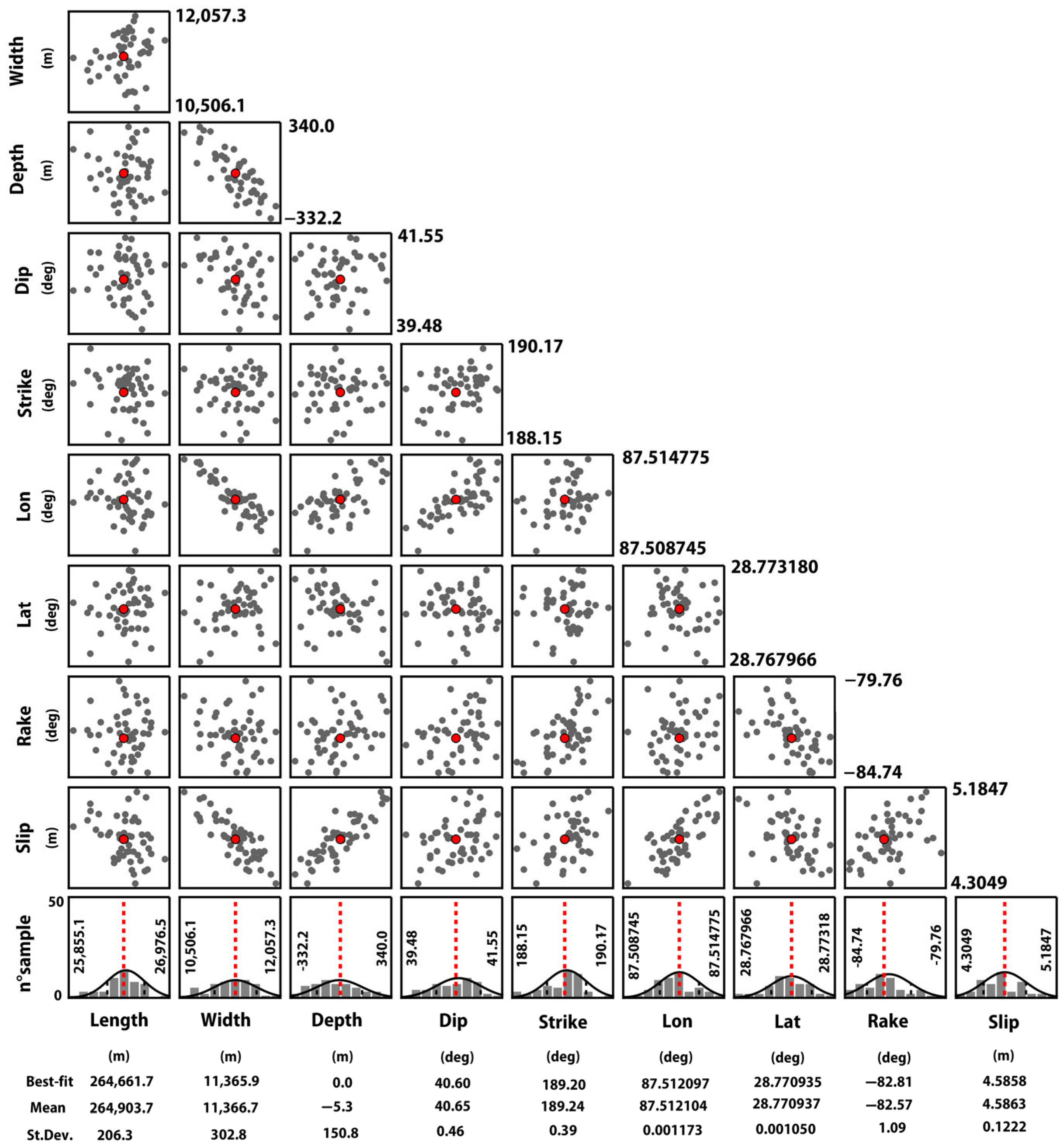The Tectonic Significance of the Mw7.1 Earthquake Source Model in Tibet in 2025 Constrained by InSAR Data
Abstract
1. Introduction

2. Geological Structural Background
3. InSAR Data Processing and Deformation Analysis
4. Inversion of Fault Geometry and Slip Distribution
4.1. Inversion of Fault Geometry
4.2. Inversion of Fault Slip Distribution
5. Regional Earthquake Hazard Assessment
6. Discussion
7. Conclusions
Author Contributions
Funding
Data Availability Statement
Acknowledgments
Conflicts of Interest
References
- Global Major Earthquake Real-Time Response Team, Ground Motion Intensity Assessment Dataset for the M6.8 Dingri Earthquake in Xizang Province. 2025. Available online: https://data.earthquake.cn (accessed on 27 January 2025).
- Liu, Y.H.; Shan, X.J.; Zhang, Y.F.; Zhao, D.Z.; Qu, C.Y. Use of seismic waveforms and InSAR data for determination of the seismotectonics of the mainling Ms 6.9 earthquake on Nov.18, 2017. Seismol. Geol. 2018, 40, 1254–1275. (In Chinese) [Google Scholar]
- Bagnardi, M.; Hooper, A. Inversion of surface deformation data for rapid estimates of source parameters and uncertainties: A Bayesian approach. Geochem. Geopysicas Geosyst. 2018, 19, 2194–2211. [Google Scholar] [CrossRef]
- Moral, P.D.; Doucet, A.; Jasra, A. Sequential Monte Carlo samplers. J. R. Stat. Soc. 2006, 68, 411–436. [Google Scholar] [CrossRef]
- Vasyura-Bathke, H.; Dettmer, J.; Steinberg, A.; Heimann, S.; Jónsson, S. The Bayesian earthquake analysis tool. Seismol. Res. Lett. 2020, 91, 1003–1018. [Google Scholar] [CrossRef]
- Wang, R.J.; Diao, F.Q.; Hoechner, A. SDM—A geodetic inversion code incorporating with layered crust structure and curved fault geometry. Proc. EGU Gen. Assem. 2013, 15, 2411. [Google Scholar]
- Zhao, B. Relocating Catalogue of M6.8 Earthquake Sequence in Dingri, Xizang. Available online: https://data.earthquake.cn/datashare/report.shtml?PAGEID=datasourcelist&dt=ff80808294439adf019443c969ea0001 (accessed on 27 January 2025).
- Zhang, J.-j.; Lei, G.; Lin, D. Structural characteristrics of middle and southern Xainza-Dingye normal fault system and its relationship to Southern Tibetan detachment system. Chin. Sci. Bull. 2002, 47, 738–743. (In Chinese) [Google Scholar]
- Zhang, P.-z.; Wang, W.-t.; Gan, W.-j.; Zhang, Z.-q.; Zhang, H.-p.; Zheng, D.-w.; Zheng, W.-j.; Wang, Y.; Wang, Y.-j.; Xu, B.-b.; et al. Present-day deformation and geodynamic processes of the Tibetan Plateau. Acta Geol. Sincia 2022, 96, 3297–3313. [Google Scholar] [CrossRef]
- Huang, T.; Wu, Z.H.; Han, S.; Gao, Y.; Bai, W.G. The Basci Characteristics of Active Faults in the Region of Xigaze, Xizang and the Assessment of Potential Earthquake Disaster Risks. Prog. Earthq. Sci. 2024, 54, 696–711. (In Chinese) [Google Scholar]
- Wang, C.; Mouche, A.; Tandeo, P.; Stopa, J.E.; Longépé, N.; Erhard, G.; Foster, R.C.; Vandemark, D.; Chapron, B. A labelled ocean SAR imagery dataset of ten geophysical phenomena from Sentinel-1 wave mode. Geosci. Data J. 2019, 6, 105–115. [Google Scholar] [CrossRef]
- Farr, T.G.; Rosen, P.; Caro, E.; Crippen, R.; Duren, R.; Hensley, S.; Kobrick, M.; Paller, M.; Rodriguez, E.; Roth, L.; et al. The Shuttle Radar Topography Mission. Rev. Geophys. 2007, 45, 1–33. [Google Scholar] [CrossRef]
- Goldstein, R.M. Atmospheric limitations to repeat-track radar interferometry. Geophys. Res. Lett. 1995, 22, 2517–2520. [Google Scholar] [CrossRef]
- Werner, C.; Wegmuller, U.; Strozzi, T.; Wiesmann, A. Processing strategies for phase unwrapping for InSAR applications. In Proceedings of the European Conference on Synthetic Aperture Radar (EUSAR 2002), Cologne, Germany, 4–6 June 2002. [Google Scholar]
- Lohman, R.B.; Simons, M. Some thoughts on the use of InSAR data to constrain models of surface deformation: Noise structure and data downsampling. Geochem. Geophys. Geosystems 2005, 61, Q01007. [Google Scholar] [CrossRef]
- Steck, L.K.; Phillips, W.S.; Mackey, K.; Begnaud, M.L.; Stead, R.J.; Rowe, C.A. Seismic tomography of crustal P and S across Eurasia. Geophys. J. Int. 2009, 177, 81–92. [Google Scholar] [CrossRef]
- Fukuda, J.; Johnson, K.M. A fully Bayesian inversion for spatial distribution of fault slip with objective smoothing. Bull. Seismol. Soc. Am. 2008, 98, 1128–1146. [Google Scholar] [CrossRef]
- Toda, S.; Stein, R.S.; Richards, D.K.; Bozkurt, S. Forecasting the Evolution of Seismicity in Southern California: Animations Built on Earthquake Stress Transfer. J. Geophys. Res. Solid Earth 2005, 110, S21C-2. [Google Scholar] [CrossRef]
- Barbot, S.; Fialko, Y.; Bock, Y. Postseismic deformation due to the Mw 6.0 2004 Parkfield earthquake: Stress-driven creep on a fault with spatially variable rate-and-state friction parameters. J. Geophys. Res. 2009, 114, B07405. [Google Scholar] [CrossRef]
- Lin, J.; Stein, R.S. Stress triggering in thrust and subduction earthquakes and stress interaction between the southern San Andreas and nearby thrust and strike-slip faults. J. Geophys. Geophys. Res. Solid Earth 2004, 109, b02303. [Google Scholar] [CrossRef]
- Harris, R.A. Introduction to special section: Stress triggers, stress shadows, and implications for seismic hazard. J. Geophys. Res. Solid Earth 1998, 103, 24347–24358. [Google Scholar] [CrossRef]
- Liu, J.; Ji, C.; Zhang, J.; Zhang, P.; Zeng, L.; Li, Z.; Wang, W. Tectonic setting and general features of coseismic rupture of the 25 April 2015 Mw7.8 Gorkha, Nepal earthquake. Chin. Sci. Bull. 2015, 60, 2604–2655. (In Chinese) [Google Scholar]
- Zhu, Z.-C.; Song, H.-L. Tectonic Geology; China University of Geosciences Press: Wuhan, China, 1999. (In Chinese) [Google Scholar]
- Shi, Y.-Q.; Feng, X.-J.; Dai, W.-Q.; Ren, J.; Li, X.-N.; Han, H.-Y. Distribution and structural characteristics of the Xi’an section of the Weihe fault. Acta Seismol. Sin. 2008, 30, 634–647. (In Chinese) [Google Scholar] [CrossRef]
- Wei, X.; Tan, K.; Liu, G.; Qiao, X.-J.; Nie, Z.-S. Coseismic and postseismic coulomb stress changes on surrounding major faults caused by the 2015 Nepal Mw7.9 earthquake. Chin. J. Geophys. 2015, 58, 4305–4316. [Google Scholar]
- Zhang, X.; Zhang, Z.; Wang, J.; Wang, S.; Yang, X.; Zhuan, S.; Hou, D.; Zhang, Z.; Zhang, L.; Cheng, Z. Further discussion on the formation and evolution of the Yarlung Zangbo suture zone, Tibet. Geol. China 2019, 47, 944–970, (In Chinese with Engish abstract). [Google Scholar] [CrossRef]







| Source | Longitude/East (°) | Latitude/ North (°) | D/km | Nodal Plane I/(°) | Nodal Plane II/(°) | Earthquake Magnitude | ||||
|---|---|---|---|---|---|---|---|---|---|---|
| Strike | Dip | Rake | Strike | Dip | Rake | |||||
| GCMT | 87.361 | 28.639 | 10.0 | 349 | 42 | −103 | 187 | 49 | −88 | Mw7.1 |
| USGS | 87.47 | 28.56 | 12.0 | 356 | 42 | −88 | 173 | 48 | −92 | Mw7.1 |
| CEA | 87.45 | 28.5 | 10.0 | 356.29 | 43.66 | −102.76 | 184.35 | 47.67 | −78.11 | Mw7.0 |
| This study | 87.48 | 28.62 | 5.0 | 189.2 | 40.6 | −82.81 | / | / | / | Mw7.1 |
| Orbit Direction (Orbit Number) | Imaging Date | Polarization Mode | Azimuth of Line of Sight α/(°) | Incidence Angle of Line of Sight θ/(°) | Spatial Baseline (m) | Time Baseline (d) | |
|---|---|---|---|---|---|---|---|
| Before Earthquake | After Earthquake | ||||||
| Asc (T12) | 5 January 2025 | 17 January 2025 | VV | −12.59 | 34.59 | −18.758 | 12 |
| Des (T121) | 1 January 2025 | 13 January 2025 | VV | −167.37 | 34.62 | −6.254 | 12 |
| Des (T48) | 27 December 2024 | 8 January 2025 | VV | −167.38 | 34.63 | −49.067 | 12 |
Disclaimer/Publisher’s Note: The statements, opinions and data contained in all publications are solely those of the individual author(s) and contributor(s) and not of MDPI and/or the editor(s). MDPI and/or the editor(s) disclaim responsibility for any injury to people or property resulting from any ideas, methods, instructions or products referred to in the content. |
© 2025 by the authors. Licensee MDPI, Basel, Switzerland. This article is an open access article distributed under the terms and conditions of the Creative Commons Attribution (CC BY) license (https://creativecommons.org/licenses/by/4.0/).
Share and Cite
Yu, S.; Zhang, S.; Luo, J.; Li, Z.; Ding, J. The Tectonic Significance of the Mw7.1 Earthquake Source Model in Tibet in 2025 Constrained by InSAR Data. Remote Sens. 2025, 17, 936. https://doi.org/10.3390/rs17050936
Yu S, Zhang S, Luo J, Li Z, Ding J. The Tectonic Significance of the Mw7.1 Earthquake Source Model in Tibet in 2025 Constrained by InSAR Data. Remote Sensing. 2025; 17(5):936. https://doi.org/10.3390/rs17050936
Chicago/Turabian StyleYu, Shuyuan, Shubi Zhang, Jiaji Luo, Zhejun Li, and Juan Ding. 2025. "The Tectonic Significance of the Mw7.1 Earthquake Source Model in Tibet in 2025 Constrained by InSAR Data" Remote Sensing 17, no. 5: 936. https://doi.org/10.3390/rs17050936
APA StyleYu, S., Zhang, S., Luo, J., Li, Z., & Ding, J. (2025). The Tectonic Significance of the Mw7.1 Earthquake Source Model in Tibet in 2025 Constrained by InSAR Data. Remote Sensing, 17(5), 936. https://doi.org/10.3390/rs17050936







